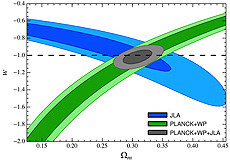Sloan Digital Sky Survey and the cosmological constant
 |
| The allowed region for cosmological parameters according the recent analysis of supernova data combined with the previously published results from the Planck satellite data.
|
The Sloan Digital Sky Survey supernova (SDSS SN) survey was born in 2004, when a team led by Fermilab's Josh Frieman was approved as part of the first extension of the original survey. Frieman, now leader of the Dark Energy Survey, recognized that the wide-field-of-view Sloan telescope made it an ideal instrument to observe supernovae — extremely bright, exploding stars.
The Sloan supernova project has resulted in more than 30 publications, including the recent paper of Betoule, et al, to be published in Astronomy and Astrophysics. It is the most precise analysis of supernova data to date.
Stars in the type Ia class of supernovae explode with the same intrinsic brightness. Thus scientists can determine the distance to a supernova by measuring the apparent brightness as seen from Earth. The wavelength of distant light is shifted toward redder colors, and the amount of redshift reveals how long ago the light was emitted. Taken together, the measurements of the supernova brightness and redshift allow scientists to determine the size of the universe as a function of cosmic time.
The Nobel Prize-winning discovery of Perlmutter, Riess and Schmidt showed the expansion of the universe is now accelerating, not decelerating from gravity as expected. The phenomenon is called dark energy, and its properties are often described in terms of the ratio of its pressure to its density — a ratio called w. Einstein's equations for general relativity include the possibility of a value called the cosmological constant, which could provide the mathematical description of dark energy if the value of w is exactly -1. Any other result requires some other modification to Einstein's equations.
The Sloan supernova survey and a similar, higher-redshift survey known as the Supernova Legacy Survey formed a "joint lightcurve analysis" group (JLA) to analyze supernova data from both surveys. The full SDSS SN sample and essential improvements in analysis technique produced the new, precise result.
The figure above shows the result of the JLA analysis and illustrates the effectiveness of combining the supernova data with data from the Planck satellite, which has provided the most precise measurement of the cosmic microwave background. Along the horizontal axis, labeled ΩM, is the fraction of the universe that consists of ordinary matter, and w is the parameter that describes dark energy. The color contours show the experimentally allowed region for these cosmological parameters. The gray region shows the combination of the Planck and the JLA results.
The measured value of w is -1.018 ± 0.057 and is consistent with Einstein's cosmological constant. Nevertheless, it is still only a step towards understanding dark energy.
—John Marriner
|